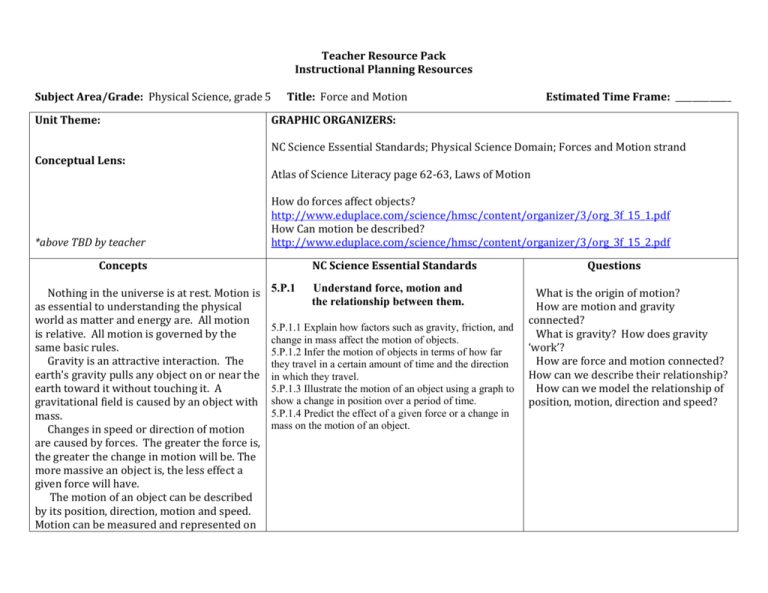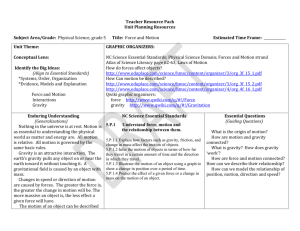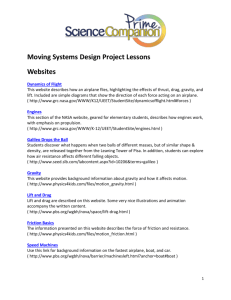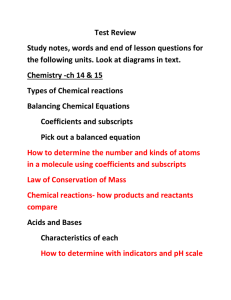RP Force_and_Motion5thgrade Oct2013
advertisement

Teacher Resource Pack Instructional Planning Resources Subject Area/Grade: Physical Science, grade 5 Unit Theme: Conceptual Lens: *above TBD by teacher Title: Force and Motion GRAPHIC ORGANIZERS: NC Science Essential Standards; Physical Science Domain; Forces and Motion strand Atlas of Science Literacy page 62-63, Laws of Motion How do forces affect objects? http://www.eduplace.com/science/hmsc/content/organizer/3/org_3f_15_1.pdf How Can motion be described? http://www.eduplace.com/science/hmsc/content/organizer/3/org_3f_15_2.pdf Concepts Nothing in the universe is at rest. Motion is as essential to understanding the physical world as matter and energy are. All motion is relative. All motion is governed by the same basic rules. Gravity is an attractive interaction. The earth's gravity pulls any object on or near the earth toward it without touching it. A gravitational field is caused by an object with mass. Changes in speed or direction of motion are caused by forces. The greater the force is, the greater the change in motion will be. The more massive an object is, the less effect a given force will have. The motion of an object can be described by its position, direction, motion and speed. Motion can be measured and represented on Estimated Time Frame: _____________ NC Science Essential Standards 5.P.1 Understand force, motion and the relationship between them. 5.P.1.1 Explain how factors such as gravity, friction, and change in mass affect the motion of objects. 5.P.1.2 Infer the motion of objects in terms of how far they travel in a certain amount of time and the direction in which they travel. 5.P.1.3 Illustrate the motion of an object using a graph to show a change in position over a period of time. 5.P.1.4 Predict the effect of a given force or a change in mass on the motion of an object. Questions What is the origin of motion? How are motion and gravity connected? What is gravity? How does gravity ‘work’? How are force and motion connected? How can we describe their relationship? How can we model the relationship of position, motion, direction and speed? a graph. Terminology Gravity mass friction axis Identify Misconceptions *Construct formative assessment probes – see ‘how to’ on pages 85, 102, and 183 in Science Formative Assessment by Page Keeley. Use formative probes: Uncovering Student ideas in Science, Volumes 1-4, by Page Keeley I) Volume 1 Talking About Gravity p. 97 II) Volume 3 Apple on a Desk p.63 III) Volume 3 Rolling Marbles p. 71 IV) Volume 3 Dropping Balls p. 77 Formative Assessment Probes (articles, how-to, free-online) by Page Keeley, et al http://pal.lternet.edu/docs/outreach/educators/education_pedagogy_research/assessment_probes_uncovering_student_ideas.pdf http://www.ode.state.or.us/teachlearn/subjects/science/resources/msef2010-formative_assessment_probes.pdf Framework for K-12 Science Education Core Idea PS2: Motion and Stability: Forces and Interactions PS2.A: Forces and Motion PS2.B: Types of Interactions PS2.C: Stability and Instability in Physical Systems *beginning on document page 113, pdf page 128 Unpacked Content 5.P.1.1 Students know that gravity pulls any object on or near the earth toward it without touching it. Students know that friction is a force that is created anytime two surfaces move or try to move across each other. Students know that all matter has mass. Students understand that changing any or all of these factors will affect the motion of an object. 5.P.1.2 Students know that it is possible to measure the motion of an object based on the distance it will travel in a certain amount of time. Science For All Americans Motion is as much a part of the physical world as matter and energy are. Everything moves—atoms and molecules; the stars, planets, and moons; the earth and its surface and everything on its surface; all living things, and every part of living things. Nothing in the universe is at rest. Since everything is moving, there is no fixed reference point against which the motion of things can be described. All motion is relative to whatever point or object we choose. Thus, a parked bus has no motion with reference to the earth's surface; but since the earth spins on its axis, the bus is moving about 1,000 miles per hour around the center of the earth. If the bus is moving down the highway, then a person walking up the aisle of the bus has one speed with reference Benchmarks Reference http://www.project2061.or g/publications/bsl/online/i ndex.php 4F 4G 5.P.1.3 Students know that a graph can be created using one axis to represent the distance that an object travels, and the other axis to represent the period of time the object is traveling. Students know how to construct a graph that demonstrates a relation of distance to time. 5.P.1.4 Students know that the greater a force is, the greater the change (in motion) it produces. The greater the mass of the object being acted on, the less the effect of the (same) force. to the bus, another with respect to the highway, and yet another with respect to the earth's center. There is no point in space that can serve as a reference for what is actually moving. Changes in motion—speeding up, slowing down, changing direction—are due to the effects of forces. Any object maintains a constant speed and direction of motion unless an unbalanced outside force acts on it. When an unbalanced force does act on an object, the object's motion changes. Depending on the direction of the force relative to the direction of motion, the object may change its speed (a falling apple) or its direction of motion (the moon in its curved orbit), or both (a fly ball). The greater the amount of the unbalanced force, the more rapidly a given object's speed or direction of motion changes; the more massive an object is, the less rapidly its speed or direction changes in response to any given force. And whenever some thing A exerts a force on some thing B, B exerts an equally strong force back on A. For example, iron nail A pulls on magnet B with the same amount of force as magnet B pulls on iron nail A—but in the opposite direction. In most familiar situations, friction between surfaces brings forces into play that complicate the description of motion, although the basic principles still apply. Everything in the universe exerts gravitational forces on everything else, although the effects are readily noticeable only when at least one very large mass is involved (such as a star or planet). Gravity is the force behind the fall of rain, the power of rivers, the pulse of tides; it pulls the matter of planets and stars toward their centers to form spheres, holds planets in orbit, and gathers cosmic dust together to form stars. Gravitational forces are thought of as involving a gravitational field that affects space around any mass. The strength of the field around an object is proportional to its mass and diminishes with distance from its center. For example, the earth's pull on an individual will depend on whether the person is, say, on the beach or far out in space. North Carolina Connections: Catawba Science Center CSC also provides a variety of educational and fun programming for school groups, children, families, adults, and other community groups. 243 3rd Avenue NE (street address), P.O. Box 2431, Hickory, NC 28603, (828) 322-8169 Imagination Station Science Museum Interactive programs are designed to promote student investigation into various science concepts. 224 East Nash Street,Wilson, NC 27894 Phone (252) 291-5113. North Carolina Museum of Life and Science Experience how inquiry-based teaching energizes your students and encourages science discovery. 433 West Murray Avenue (street address), P.O. Box 15190, Durham, NC 27704, (919) 220-5429 SciWorks, the Science Center and Environmental Park of Forsyth County Enjoy interactive, hands-on special exhibits and programs in spacious exhibit halls. 400 West Hanes Mill Rd., Winston-Salem, (336) 7676730 Annotated Teaching Resources Slow the Ball http://serc.carleton.edu/sp/mnstep/activities/27614.html Student small group physics challenge. Engaging and challenging. Hurricanes 1: The Science of Hurricanes http://www.sciencenetlinks.com/lessons.cfm?BenchmarkID=4&DocID=312 This lesson is the first of a two-part series on the science of hurricanes and the kinds of technology being used to identify and track them. In this segment, students examine different scientific aspects of hurricanes, all in an effort to begin to understand the nature of motion, particularly how changes in speed or direction of motion are caused by forces. Hurricanes 2: Tracking Hurricanes http://www.sciencenetlinks.com/lessons.php?BenchmarkID=3&DocID=314 The purpose of this lesson is to examine the role of technology in identifying and tracking hurricanes. It is the second in a two-part series on the science of hurricanes and the kinds of technology being used to identify and track them. Students broaden their study by exploring how technology and science are used today to identify, measure, and track powerful tropical storms to better warn and secure ... Science in Focus: Force and Motion Workshops for Teachers http://www.learner.org/workshops/force/ These eight free professional development workshops for K-8 teachers present science concepts in force and motion. They are designed so that teachers come away with an understanding that will help them engage their students in their own explorations. The workshops cover gravity, friction, air resistance, magnetism, and tension through activities, discussions, and demonstrations. Marble Roller Coaster engineering challenge http://www.centexeweek.org/activities/marble-rollercoaster In this activity students build a marble roller coaster to specific engineering design specifications using only marbles, tape, and recycled file folders. http://www.raft.net/ideas/Marble%20Rollercoaster.pdf A more complex version incorporating additional materials. http://www.msichicago.org/online-science/activities/activity-detail/activities/build-a-roller-coaster/ Here is a version using online directions and pipe insulation foam. Motion Graphs http://www.mysciencesite.com/motion_graphs.pdf A reading that explains a variety of motion graphs. The Moving Man http://phet.colorado.edu/en/simulation/moving-man Learn about position, velocity, and acceleration graphs. Move the little man back and forth with the mouse and plot his motion. Distance Time Graph Activity http://graphs.mathwarehouse.com/distance-time-graph-activity.php Students explore the relationship between distance and time as they move a space ship across the screen. Fast Cars http://www.upd8.org.uk/activity/213/Fast-car.html Fast cars fire up interest even for those who can't afford them. Fast talking TV presenters tempt us with terminology and hype. But does it make any sense? Here's a chance for students to turn Top Gear researcher and refine their skills in interpreting graphs in order to write a car review for TV. Motion and Forces at Learning Science.org http://www.learningscience.org/psc2bmotionforces.htm This is a collection of computer simulations that involve students in learning about force and motion while they guide skateboarders, use machines, and more. Physics4Kids http://www.physics4kids.com/files/motion_intro.html Another of Rader’s sites that explains force, motion, gravity and more to kids in easy-to-understand language. Smart Exchange http://exchange.smarttech.com/index.html#tab=0 A directory of Smart Board lessons that teachers can download and use. Teachers Domain http://www.teachersdomain.org/ Free digital media for educational use. Bill Nye on Motion http://www.gamequarium.org/cgi-bin/search/linfo.cgi?id=8442 Bill Nye on Gravity http://www.gamequarium.org/cgi-bin/search/linfo.cgi?id=7895 Forces in Action Activity http://www.bbc.co.uk/schools/scienceclips/ages/10_11/forces_action.shtml An interactivity that allows student to load a truck with various masses, adjust slope, drag, and other factors in order to study the variables that influence motion. WRITING PROMPTS 1. Write an essay describing three pieces of playground equipment (swing, teeter-totter, slide, monkey bars). Explain how each piece of equipment works. 2. Some people think school buses ought to have seat belts. Do you agree with this, or not? Write an essay explaining your opinion and your reasons for having it. 3. Write an essay explaining the importance of car seats for young children. 4. Should police be permitted to speed whenever and wherever they must in order to apprehend a criminal? Explain what you think about this and why. 5. If you owned an amusement park, what three rides would you think you absolutely ‘must’ have in order to keep your patrons satisfied? Write an essay explaining the three rides and why you think they are essential to a popular amusement park.








